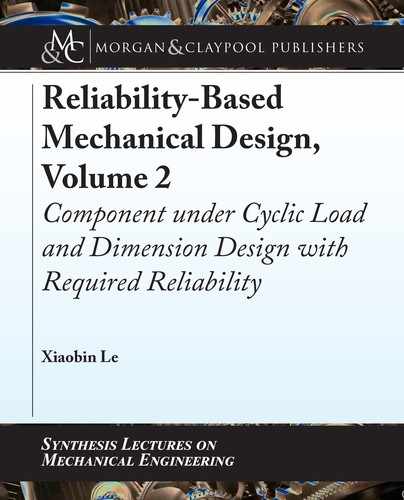
121
C H A P T E R 3
e Dimension of a
Component with Required
Reliability
3.1 INTRODUCTION
e reliability-based mechanical component design includes two main tasks: design check and
dimension design. e design check is to calculate the reliability of a component under specified
loading conditions, which have been discussed in Chapter 4 for static loading of the book [1]
and Chapter 2 for cyclic loading spectrum of this book. Dimension design of a component is
to design the component dimension with required reliability under specified loading condition.
e dimension design will be the topic of this chapter.
In Section 3.2, we will first discuss how to design the component dimension with required
reliability under specified loading condition. en, in Section 3.3, we will discuss the dimension
design with required reliability under static loading. Finally, in Section 3.4, we will discuss the
dimension design with required reliability under cyclic loading spectrum. In each loading case,
we will discuss simple loading such as axial loading, direct shearing, torsion, and bending. en,
for static loading, we will discuss component dimension design with required reliability under
several typical combined loadings. However, for cyclic loading, we will only discuss the dimen-
sion design of a rotating shaft the required reliability under the combined loading of steady
torsion with a constant or distributed bending moment.
3.2 DIMENSION DESIGN WITH REQUIRED
RELIABILITY
3.2.1 LIMIT STATE FUNCTION AND PRELIMINARY DESIGN
Component dimension d is treated as a normally distributed random variable. Its standard de-
viation
d
is determined by the manufacturing process. In mechanical component design, we
typically already choose the manufacturing process before we start to calculate its dimension. So,
the standard deviation
d
of component’s dimension can be treated as a known value. erefore,
component dimension design with the required reliability under specified loading is mainly to
determine the mean
d
of the dimension d . For dimension design with the required reliability

122 3. THE DIMENSION OF A COMPONENT WITH REQUIRED RELIABILITY
R under a specified loading condition, we will use the following general limit state function:
g
.
X
1
; : : : ; X
n
; d
/
D
8
ˆ
ˆ
<
ˆ
ˆ
:
> 0 Safe
D 0 Limit state
< 0 Failure;
(3.1)
where X
i
.i D 1; 2; : : : ; n/ is a random variable related to component strength or loading or
component geometric dimensions, which could be any type of distributions. d is a normal dis-
tribution dimension to be designed with a mean
d
and a standard deviation
d
. For component
dimension design,
d
is to be solved from the limit state function (3.1). Since the component di-
mension with
d
will have the required reliability R, the reliability index ˇ from Equation (3.1)
will be:
ˇ D ˆ
1
.
R
/
D norminv
.
R
/
; (3.2)
where ˆ
1
.
/
is the standard normal inversed CDF. norminv
.
/
is a function in MATLAB for
the standard normal inversed CDF.
For component dimension design, some design parameters are dimension-dependent. For
a component dimension design under static loading, the static stress concentration factor is
a dimension-dependent parameter. For a component dimension design under cyclic loading
spectrum, fatigue stress concentration factor and the size modification factor are dimension-
dependent parameters.
For a static stress concentration factor, we can use Tables 3.1–3.3 to estimate the prelim-
inary stress concentration factor. In Table 3.1, r is the radius of the fillet, and d is the diameter
of the smaller shaft. In Tables 3.2 and 3.3, r is the radius of the fillet, and W is the smaller width
of the bar or plate. e static stress concentration factor is mainly determined by the radius of
the fillet. Generally, we have the sketched structure of the component and know the reason
why there is a stress concentration area. erefore, we know the radius of the fillet even we do
not know the component’s dimension. When the fillet radius is determined by other mating
purchased component such as a purchased bearing, we could call it a sharp radius, as shown in
Tables 3.1 and 3.2. When the fillet radius is not restricted by another component, we might call
a well-rounded radius, as shown in Tables 3.1 and 3.2. We can use Equation (1.3) discussed in
Section 1.1 to determine the mean and the standard deviation of the static stress concentration
factor.
Table 3.1: e preliminary stress concentration factors for a shaft [2]
Shaft Bending Loading Torsion Loading Axial Loading
Shoulder fi llet–sharp (r/d = 0.02) 2.7 2.2 3.0
Shoulder fi llet–well-rounded (r/d = 0.1) 1.7 1.6 1.9
..................Content has been hidden....................
You can't read the all page of ebook, please click here login for view all page.
